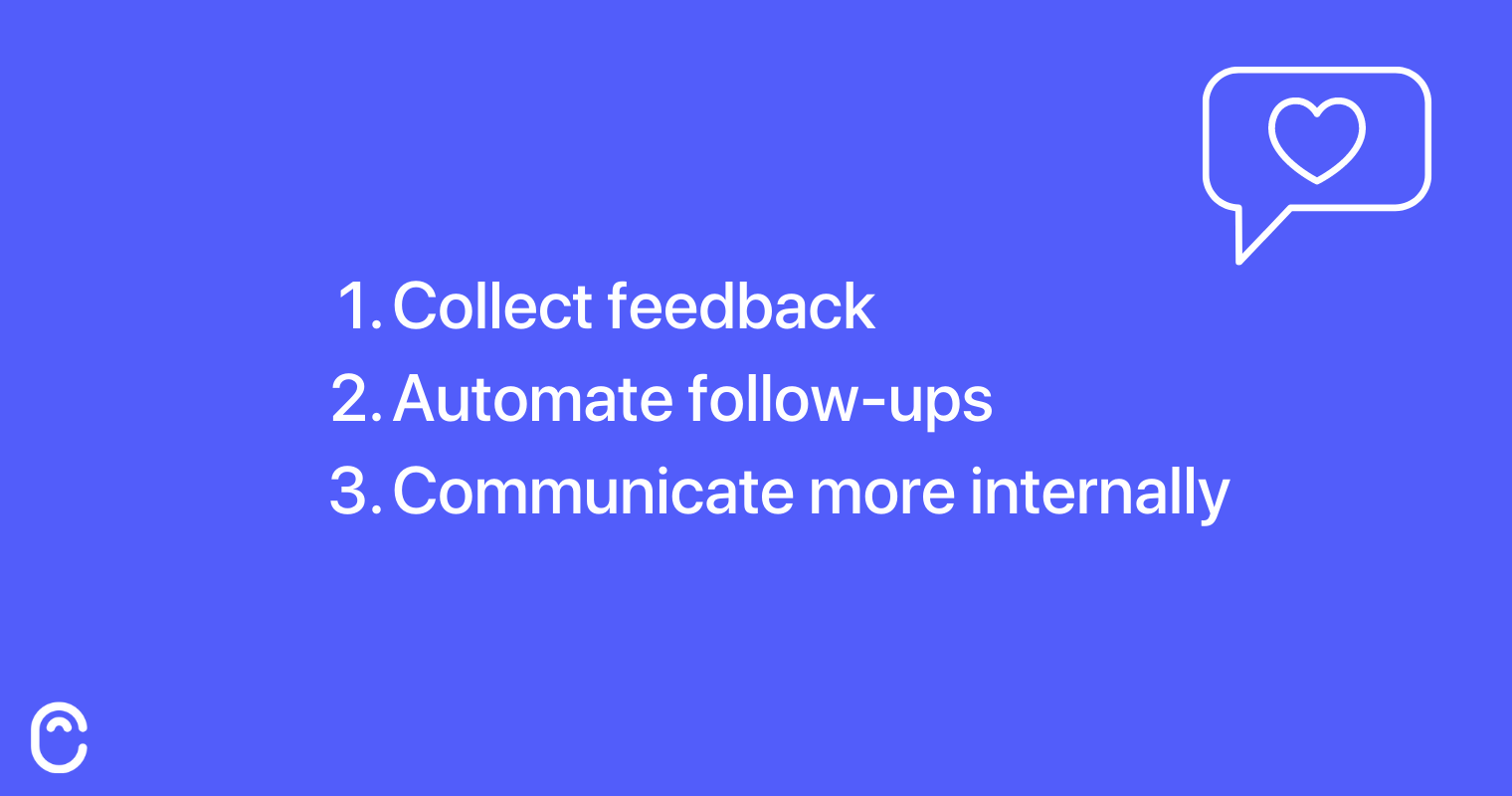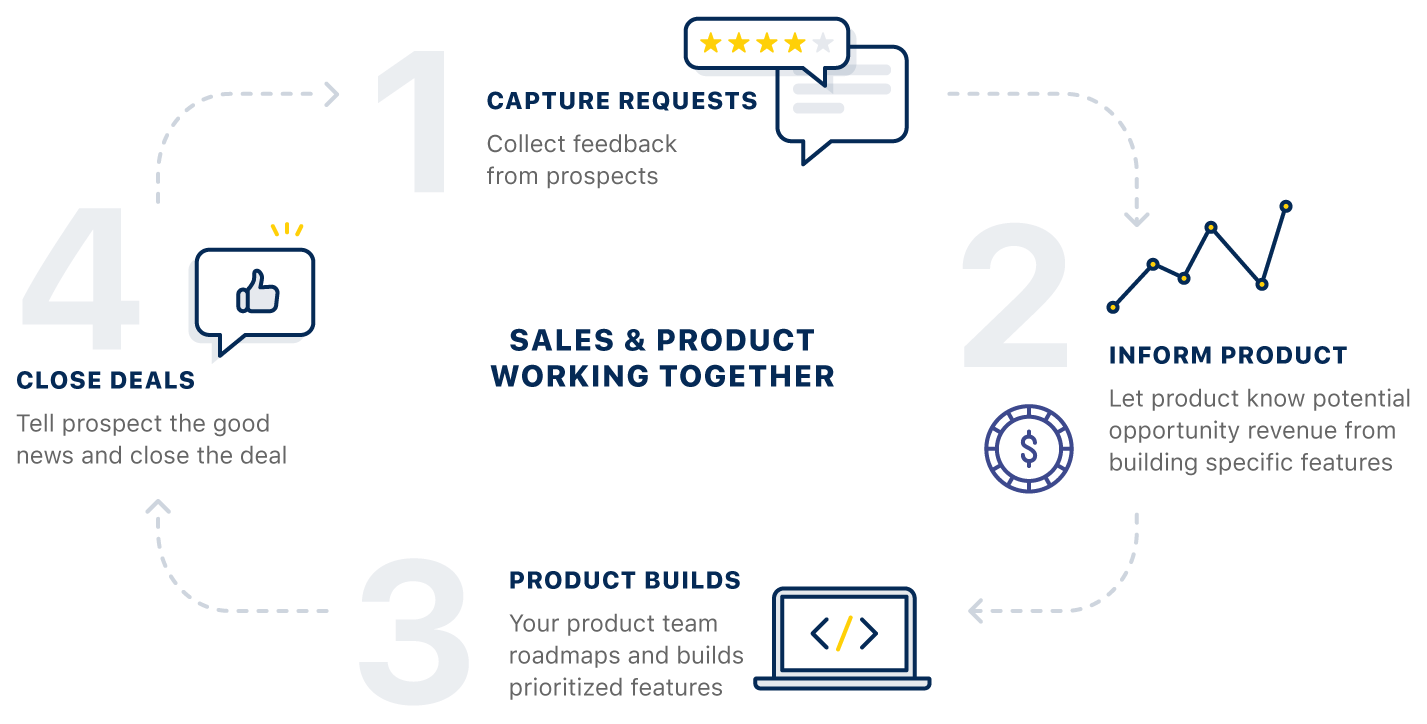When product and sales teams work well together, everyone wins.
Product builds what customers actually want and need. Sales follows up with lost leads with product updates. Product improves. Sales close. And customers are happy. Wouldn’t that be wonderful?
In reality, there are often misaligned goals, conflicting priorities, and miscommunication between these two departments. So here’s how to prevent that (or fix it)!
The sales-product disconnect
In small companies, it’s generally easy to work together. You can always hop on a call; you know what others are working on; and communication is flowing. But, as the company grows and more people join, it gets harder to figure out who’s actually responsible for what. Product and sales, ops and marketing, finance and legal – all of a sudden there are many departments and…disconnects between them.
First, let’s understand where the disconnect is coming from. It could be a number of reasons:
- Lack of communication
- Conflicting priorities
- Low visibility into each other’s work
- Disconnected data silos
All that prevents product and sales teams from supporting each other’s work and generating better results.

Product teams’ focus
A product manager generally focuses on the product lifecycle, market share, competitive positioning, and understanding users’ motivations. In other words, they really are all about the product.
They explore the industry, interview current users, and examine the competition. Their biggest task is identifying the user’s need. And they’re constantly looking for a gap in the market.
Product managers often rely on idea boards, customer interviews, and user feedback.
They focus on managing user feedback, identifying user pain points, and finding ways to address them.
PMs trust the sales team to recognize the best features of the existing product, translate them into benefits, and sell the product based on them.
While the product team can be awesome at analyzing feedback from existing customers, they may lose sight of the competitive landscape. That vital input comes from day-to-day customer conversations. Without input from the sales team, they won’t know why they’re not closing deals and losing potential customers to the competition.
Further reading — how to build your marketing roadmap
Sales teams’ focus
Sales managers gain as much product knowledge as they can to engage leads and move them through the sales cycle. That said, it’s tough for them to know as much about the product as the team who built it.
The sales process usually focuses on addressing common pain points, offering a solution, and highlighting product’s benefits.
Even when a sales rep receives solid product training, they can still lose sight of what’s happening in product development right now. While they develop their sales goals, product strategy could be going in a completely different direction.
Here’s an example: the product team identified a feature that some users have requested. It’s also a feature that certain competitors offer. Sounds like a no-brainer, right? And current users might be very happy when this feature goes live. And yet, it doesn’t help the sales team bring in new business. And here comes the disconnect.
Sales might be losing tons of deals due to a different missing feature. Building that first might represent more revenue to the organization, and likely be a bigger priority.
Lack of feedback management
We’ve seen many companies struggle with customer feedback. Some didn’t collect it at all. Some didn’t manage it properly.
Joshua Berkowitz, Head of Product at Bench, mentioned that: “It felt like a black box to the rest of the company. Nobody knew what was happening. Requests would come in and nobody would see what happened to them.”
Overall, customer experience suffers without a good feedback management strategy. And so do internal teams.

Conflicting priorities
When there’s a lack of visibility into who’s working on what, misalignment occurs.
Imagine this. You’re working on an exciting new product. You’ve gathered feedback and know that customers really want a particular feature. You’ll soon announce a product launch and the sales reps will take it away.
In reality, the sales team might be losing deals because a very important feature is missing. And they’d really love to see this particular feature developed. Then they’d be able to follow up with some prospects (who requested this important feature) and let them know about it. And possibly win a sale, right?
It works vice versa too.
Let’s say that a sales rep hears about a missing feature on client calls over and over again. But, they don’t report it back to the product team. They just assume that their product doesn’t offer this feature, so there’s nothing they can do. Their priority is to sell what already exists, not what may or may not get built in the future.
There’s so much opportunity here. What’s missing is proper communication and collaboration between the teams. This blends into our next point.
Lack of trust
Even if the salesperson identifies a gap in the current product, they may simply not feel like their voice matters. There’s a way to combat this though.
If a sales rep had a way to communicate customer feedback to the product team (and the rest of the company too), they wouldn’t really need to convince anyone. If feedback or a feature request is coming directly from a potential customer, then it’s definitely worth looking into.
Similarly, if a product strategy is informed by feedback from both customers and leads, that new feature or update will be that much easier to sell.
3 ways to break down the silos
When a customer, a user, or a prospect communicates something to you, it’s already a goldmine. It lets you know exactly:
- What they want
- What they’re lacking
- What’s stopping them from buying
- What would really make a difference for them
- What their priorities are
- What their pain points are
All you need to do is offer them an outlet where they share all of that. You’ll be surprised by how many people actually want to talk to you about your product.
And, if both product and sales teams embrace feedback management, it can really break down the silos between them. Doing this aligns the two teams to both build and sell the features that will have the biggest impact for the business.
Let’s look at the 3 key things you need to do to break down those silos.

1. Collect feedback
There are many ways of gathering user feedback. There are customer interviews, focus groups, surveys and more. Our favorite way is an idea management board.
You can invite anyone to share their feature requests, upvote and comment on existing ones, and come on the product development journey with you. Success reps and sales reps can also add requests or upvotes on behalf of their clients.
Marcus Moretti from Axios shares that: “Canny made the most important and urgent user feedback stand out, so we could innovate our product and deliver an even better product experience for our audience.”

With all of that feedback, your sales conversation will gain a brand new meaning. You’ll address their pain points directly, speak their language, and gain even more insights.
These insights, in turn, will help the product team determine what they should build next. And these new features (that users requested) will help sales close more deals. Feedback loop closed, silos broken!

Here’s how:
- Share the idea board with prospects
- Add ideas on their behalf
- Upvote requests when more people request them
- Update prospects (who requested this feature) when an update is live
Now this may sound like lots of manual work. But it doesn’t have to be – you can automate a big chunk of that..
2. Automate follow-ups
Even if you don’t build them right away, you’ll find out what features your product is missing. You can figure out what’s a dealbreaker for specific leads, and how you can follow up in the future.
In fact, there are tools that let you automate that follow-up. It looks something like this:
- You find out that feature X is missing and that’s a dealbreaker for this lead
- You add this feature request on their behalf to your idea board
- When other prospects mention the same thing, you add their vote to the same feature request
- Once this request gets enough votes (or other priority factors such as deal size the product team can start building it
- Once it’s shipped, the leads that requested this feature get an automatic notification from you
This last point really drives the point home. It’s a perfect way to not only close the feedback loop, but also re-open the sales conversation, and ultimately help you close more deals.
By integrating your idea board to your CRM, you can also get tasks to your sales team to automate their follow up efforts.
Connect your CRM and feedback management tools
Speaking of the CRM, you can take it further and integrate it with your idea board. This way, your sales team can leave feedback directly through the tool they live in every day. So no need to learn a new tool!
This benefits the product team too. They can see which features are in demand from high-priority customers and leads. Then they can prioritize those features based on the largest deal value and other important properties.
3. Communicate more internally
Feedback will help you align better across the org. You’ll see what customers (potential and existing) care about and you’ll be able to base your decisions on that.
There are other ways to improve internal communications.
Try cross-functional training: different teams can educate each other on their priorities and share how they work best.
Here are some specific ideas for product and sales orgs:
Involve the product team
Invite the product team to shadow sales calls, or even participate in technical meetings. This can build great rapport with the clients – they’ll see that everyone in the company is interested in their needs and success. At the same time, the product team will get closer to not just current customers, but prospective ones too.
Maybe the sales team is trying to appeal to a new market segment. And perhaps the product manager hasn’t gathered insights from this segment yet. This is the chance!
This will also help increase the overall visibility between two teams. And everyone will walk away understanding the product better!
Involve the sales team
Involve sales in roadmap meetings. Ask them to help with determining prioritization formulae.
They’re already talking to prospects and getting some feedback. They’re likely adding it to their CRM and identifying some common objections. So why not bring those insights to the surface?
When a few teams come together to determine priorities, you can get a fresh perspective. This lets you look at things from a whole new angle. In other words, don’t let that feedback go to waste!
Have fun
Also, fun team-building activities help to improve overall team happiness and increase trust. So important!

Ultimately, it’s all about creating shared goals and objectives. And making sure that everyone knows why the organization is following a particular path. Regular communication can really help with that.
Sell more by aligning sales and product goals
No matter which department you work in, your success is tied closely to your company’s success. And sales play a huge role in growing any company.
Right now it’s getting harder and harder to sell new tools. The economy is slow, so many companies are limiting their spending. But they’ll still buy tools they literally asked for and can’t live without. So become that tool. Align sales and product goals and build the features that will delight everyone – your current and potential customers. Feedback will help you do that.






